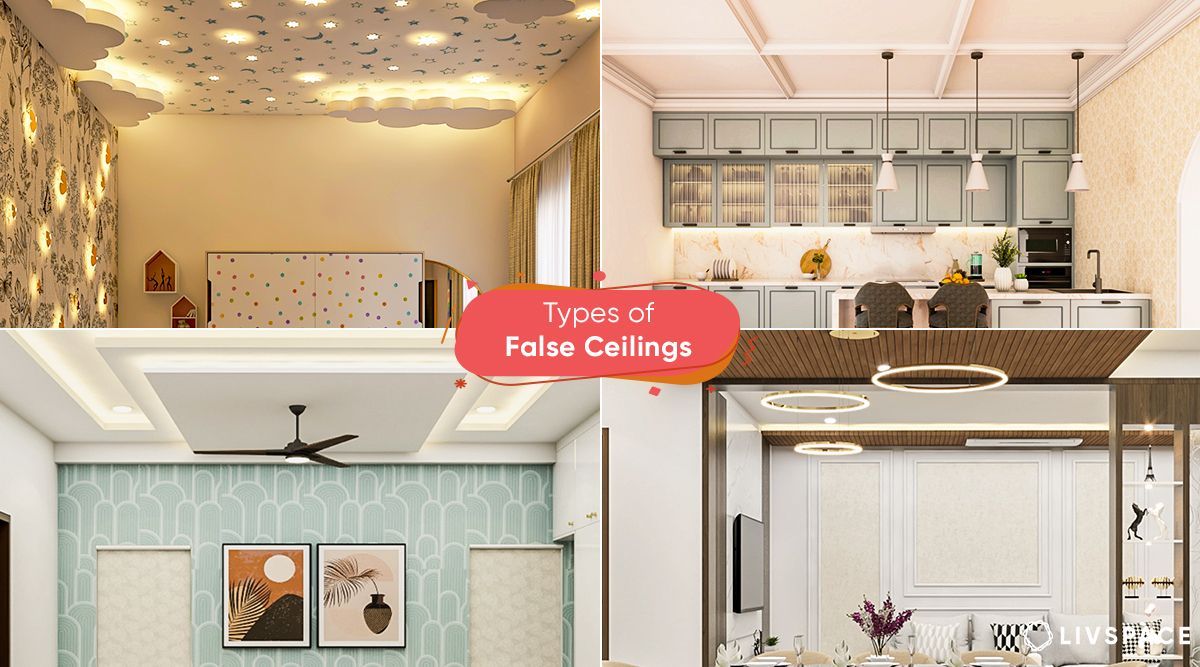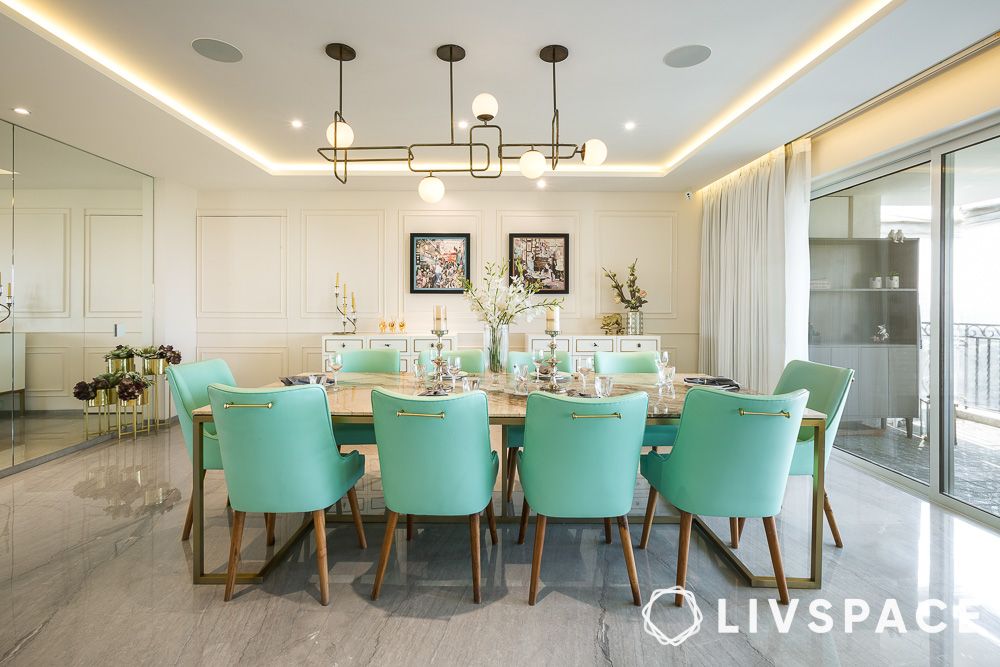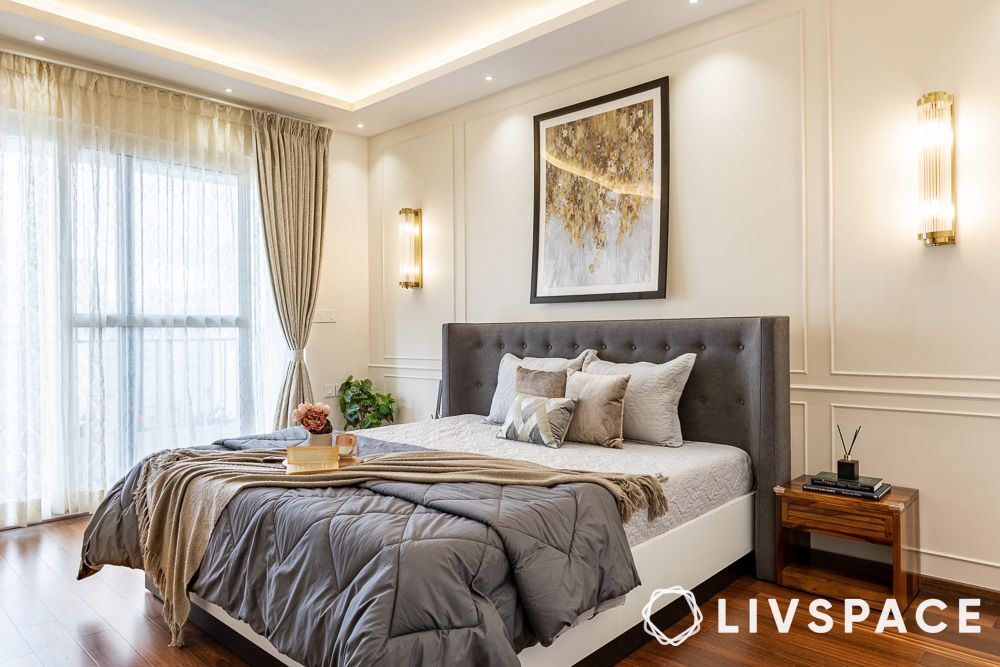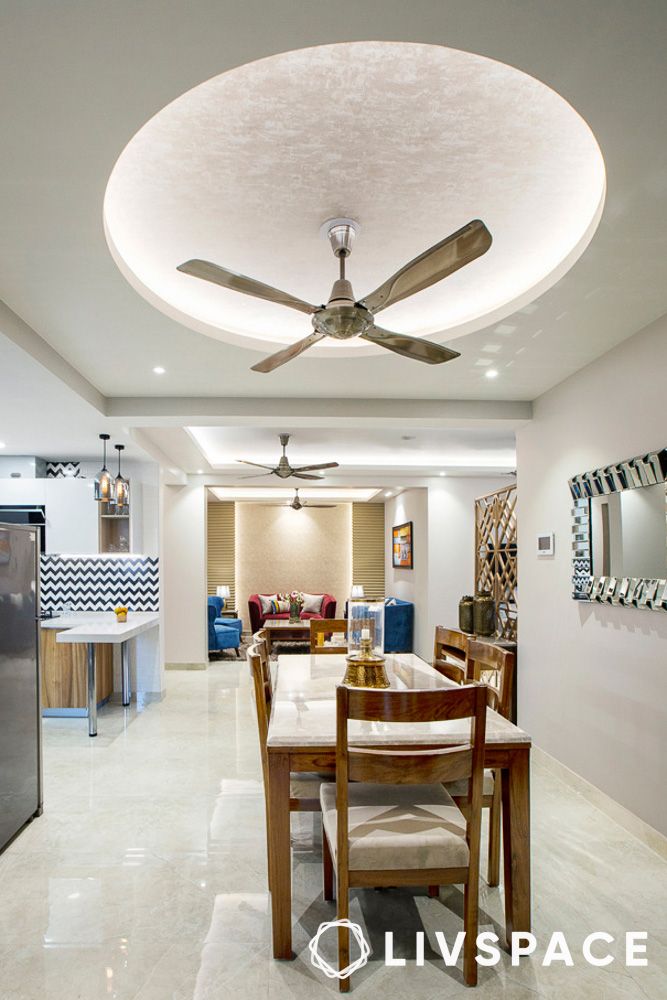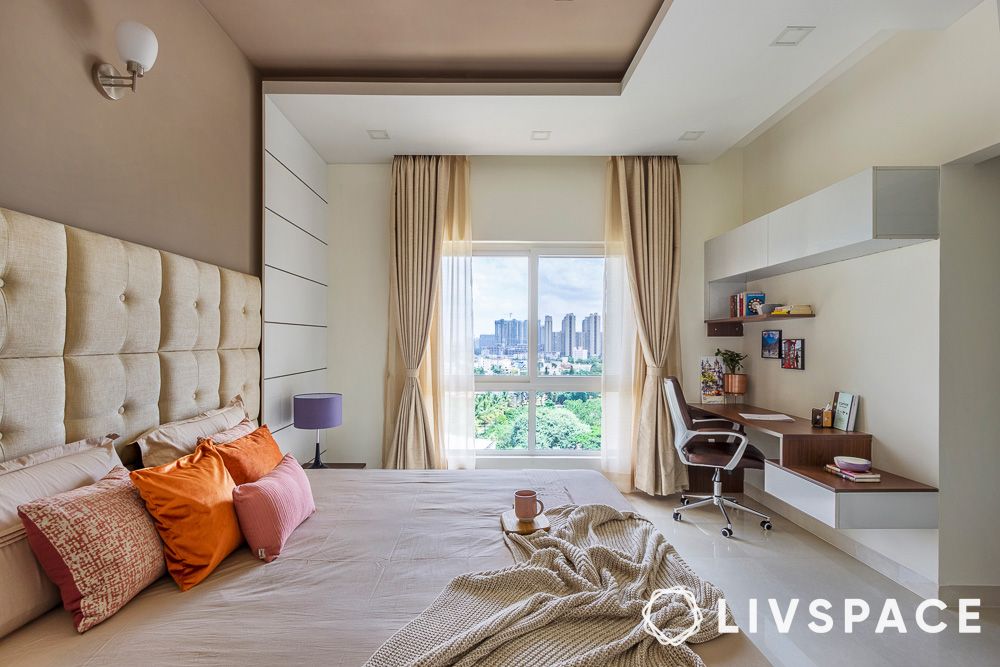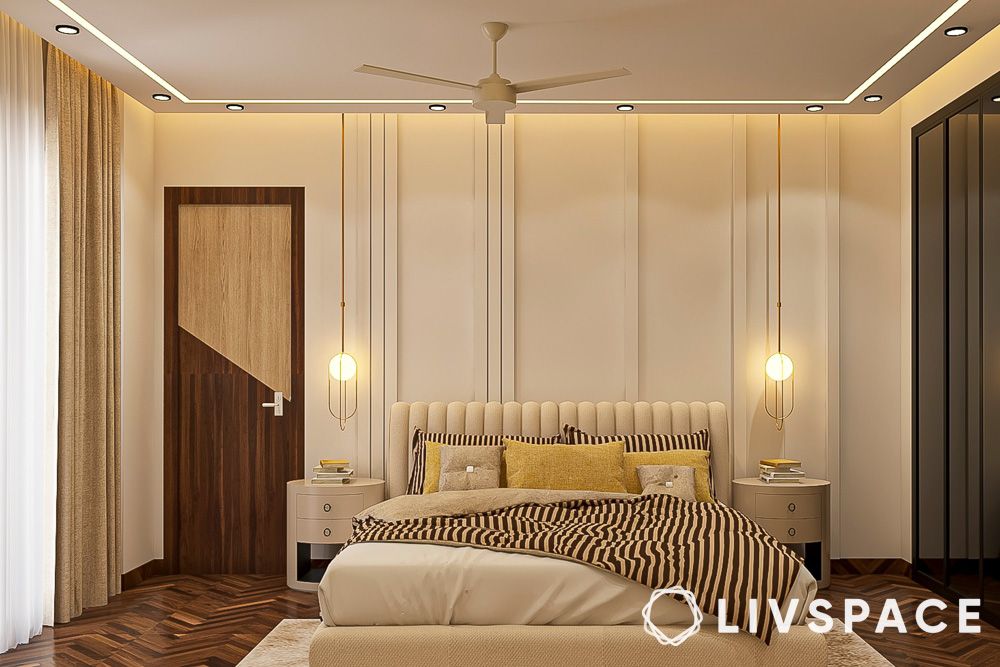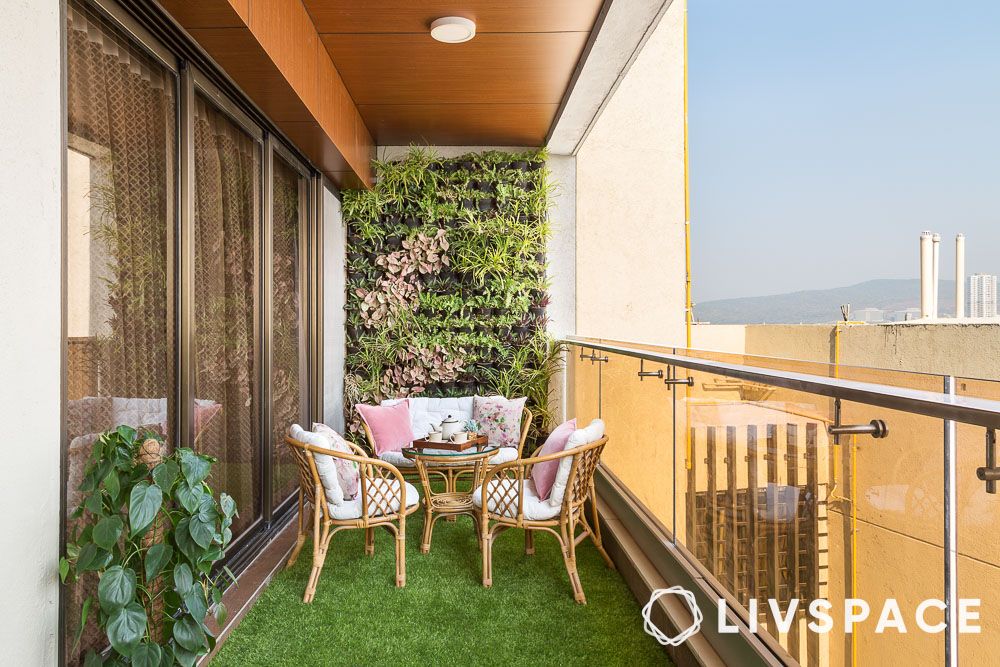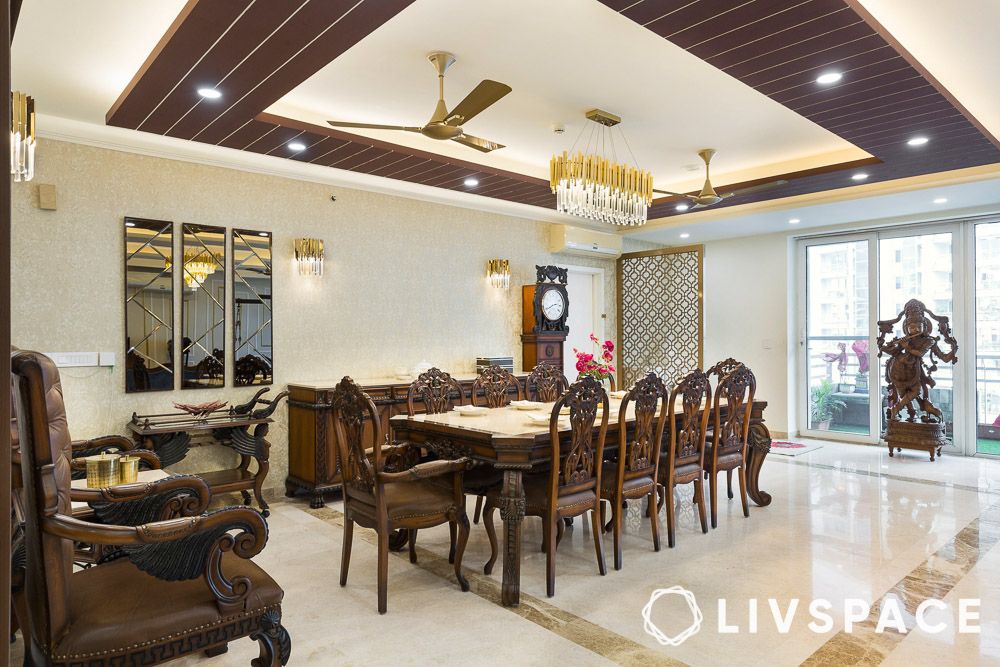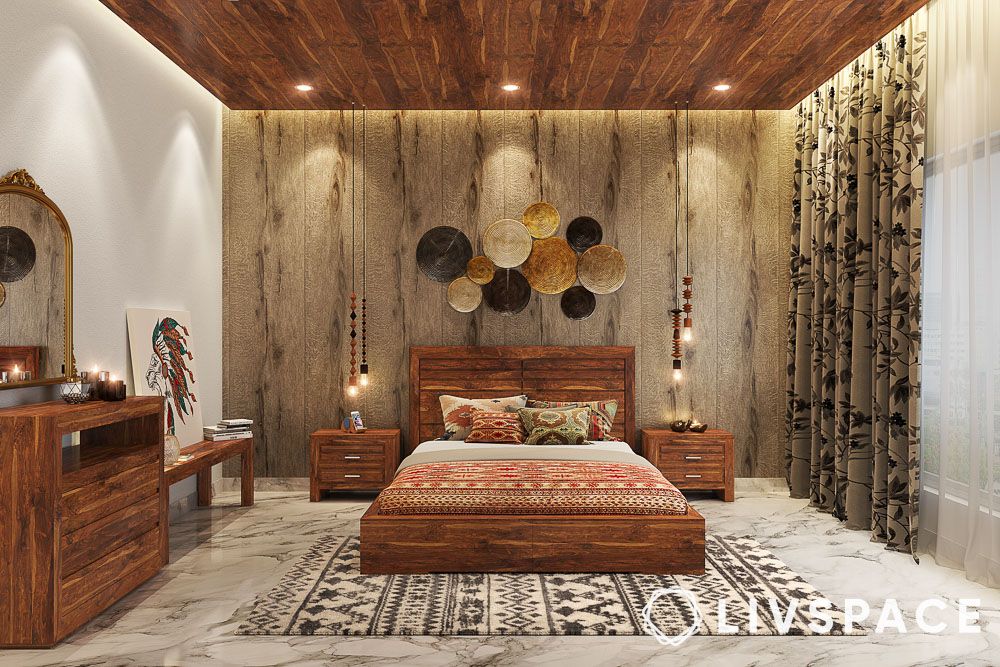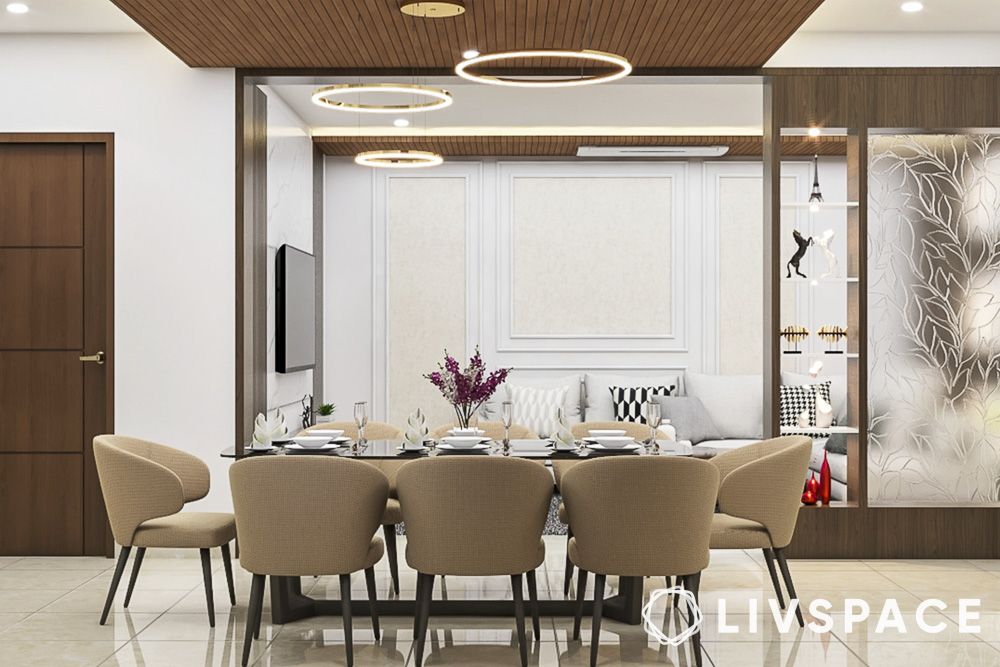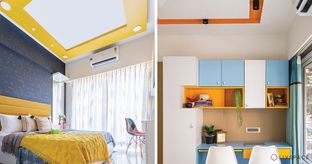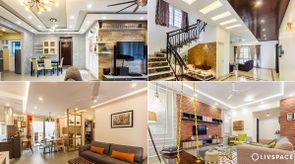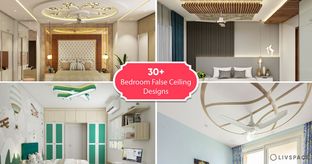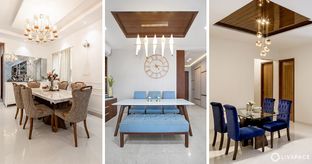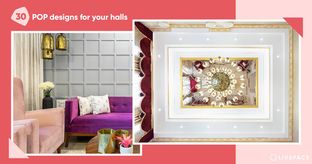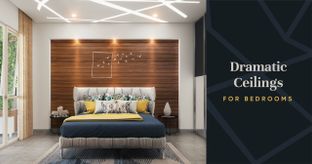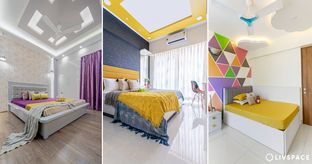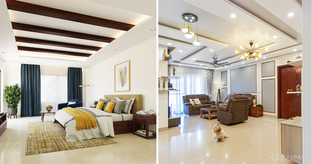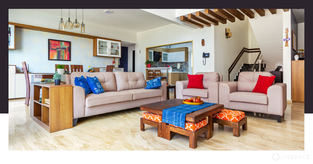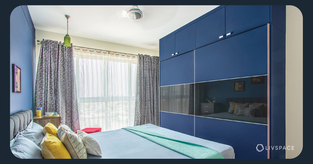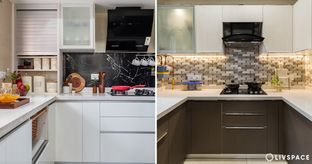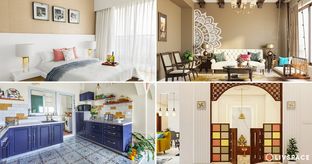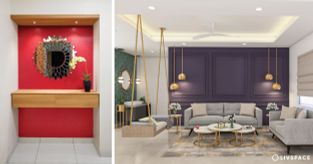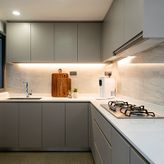In This Article
Most people ignore the details of false ceiling types in their interior design and fail to test their exceptional influence on room aesthetics. But is it just the appearance that is affected by a false ceiling? No, all false ceiling types provide thermal, moisture and sound insulation as well, apart from just regulating air, hiding wires, saving energy and providing fire-safety benefits.
Let’s find out everything there is to know about different false ceiling types and answer some frequently asked questions about them.
What is a false ceiling?
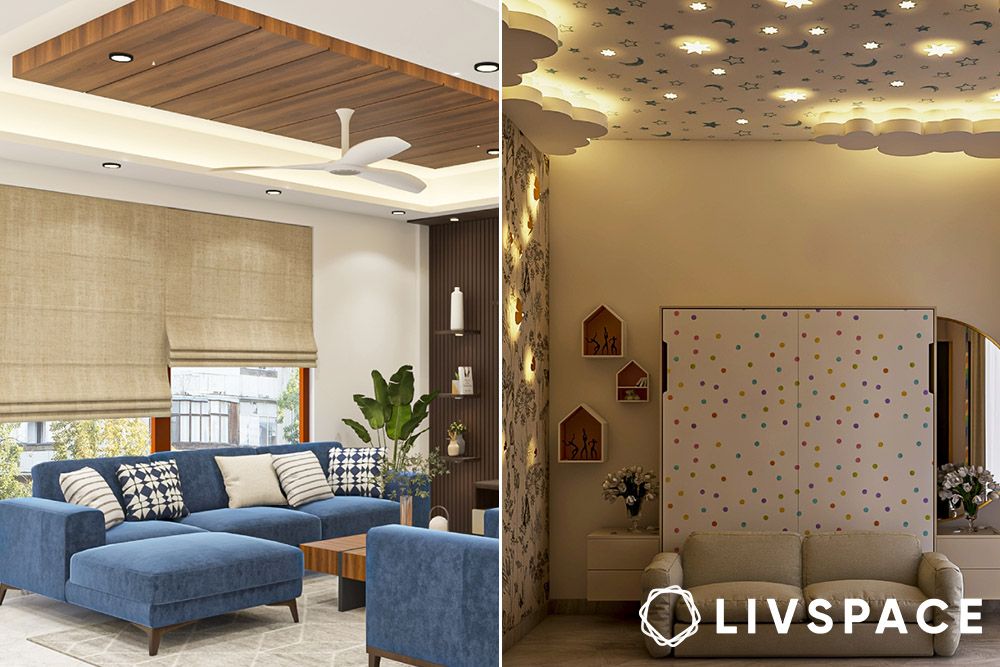
A false ceiling, also called a “dropped ceiling,” is a second ceiling hung below the real one. It’s usually attached to a frame made of wood or metal. This creates the illusion of a lower ceiling, and sometimes you can even see parts of the original ceiling peeking through. It improves appearance and provides thermal insulation, fire safety and energy conservation. And the best part – you can have one in any home, no matter how big or small!
Let’s find one for you!
Types of false ceilings by design
False ceiling type #1: Peripheral false ceiling
A peripheral false ceiling is a type of suspended ceiling design where the new ceiling is installed only around the edges of the room, leaving the centre open. These are economical options when you want to do strategic lighting and hide the wires that stick out after redoing the electrical layout. Typically made from gypsum board, PVC panels or metal tiles, the depth of its drop-down can vary depending on the desired effect and available space.
Made of: Gypsum board, PVC panels
False ceiling type #2: Island false ceiling or double layer false ceiling

Imagine a “floating island” hanging below the regular ceiling in a room. That’s essentially what an island or suspended false ceiling is! Unlike a full false ceiling that covers the entire space, an island ceiling focuses on specific areas. This kind of ceiling makes the walls appear taller than they actually are, and thereby gives a rendition of a high ceiling. It also provides heat and sound insulation, thereby conserving energy in your home.
Made of: Gypsum board, fabric panels
False ceiling type #3: Single-layered geometric false ceiling

Geometric false ceilings, apart from being incredibly appealing, are a better version of an island ceiling. This is because they provide a more thorough protection from drastic temperature changes. Also, these provide a better scope for changing electrical layouts or achieving layered lighting design that is meant to conserve energy. Additionally, these offer better protection from fire as they cover a substantial part of the original ceiling.
Made of: Gypsum boards
Also Read: 34 Latest False Ceiling Designs for Bedrooms in 2024
False ceiling type #4: Coffered false ceiling
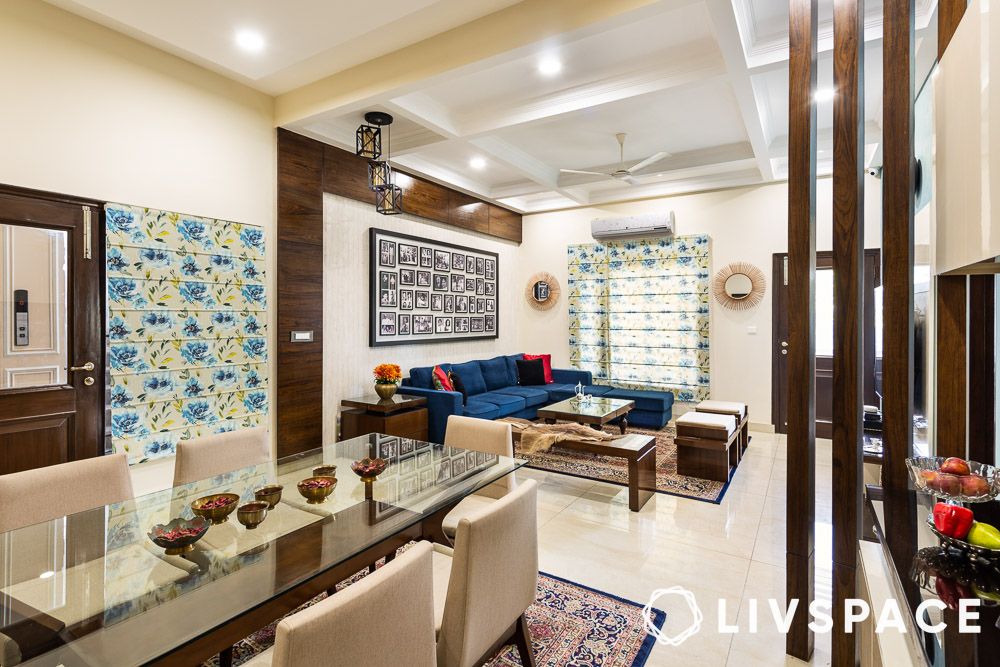
A coffered false ceiling features a series of sunken squares or recessed panels often arranged in a grid surrounded by mouldings or beams. Such ceilings reduce noise levels and improve the acoustics of your music room or home theatre. They also create an illusion of a taller ceiling that can make a room appear more spacious.
Made of: POP, wooden runners, MDF, metal (if there are no mouldings)
False ceiling type #5: Plus-minus false ceiling
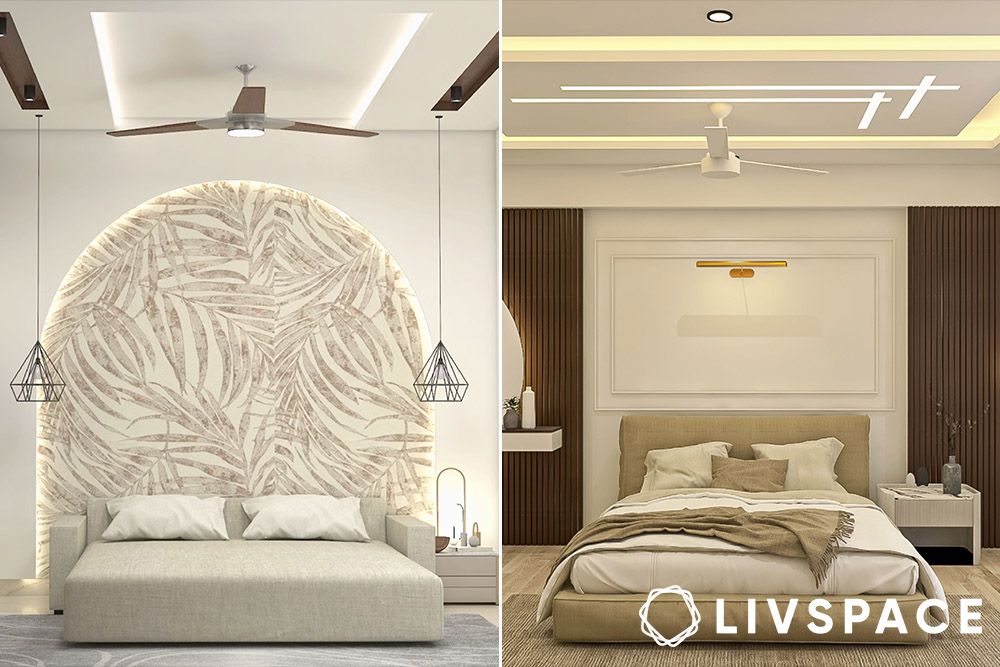
Plus-minus false ceiling designs are quite popular in India. “Plus” and “minus” refer to relative heights within the false ceiling. Imagine a design where some sections of the false ceiling are lowered (minus) compared to the main level, creating recessed areas. Other sections might protrude outwards (plus) at specific points, forming raised levels.
Made of: Gypsum
False ceiling type #6: Parallel false ceiling

A parallel false ceiling is a type of suspended ceiling system where the panels run parallel to each other, typically along the length or width of the room. They can be integrated with a variety of lighting options, such as recessed spotlights, cove lighting, and pendant lights.
Made of: POP (Plaster of Paris)
False ceiling type #7: Grid false ceiling

A grid false ceiling design, often seen in commercial spaces such as offices and retail stores, is gaining popularity for home use due to its aesthetic and functional benefits. Common materials used in grid false ceilings include gypsum and Gyproc for the modern look. The T-grid false ceiling design, with its easy installation and maintenance, is particularly favoured. This design consists of a grid framework where panels are fitted, creating a neat, modular appearance.

At home, you can use a grid ceiling design to conceal wiring and ductwork while enhancing the room’s acoustics. The gypsum grid ceiling offers excellent fire resistance, adding an extra layer of safety. While the grid false ceiling price can vary depending on materials and complexity, it remains a cost-effective option. With the versatile Gyproc grid ceiling, you can achieve a professional and polished look in any room of your home.
Made of: Gypsym and gyproc
False ceiling type #8: Curved-down ceiling designs
Curved false ceiling designs add a touch of elegance and sophistication to any space. These down ceiling designs are perfect for creating a sense of fluidity and movement in a room. Whether it’s a down ceiling POP design or a more intricate pattern, the curves can soften the edges of a room, making it feel more inviting. A curved down ceiling design for the lobby can make a striking first impression, specifically with their gentle arcs making them a great option for home entrances.
Made of: POP (Plaster of Paris)
Types of false ceilings by materials
False ceilings are usually made of POP and gypsum boards. Unless there are moulding designs on the ceilings which are done in POP, false ceilings are usually made with gypsum boards.
False ceiling type #9: Plaster of Paris false ceiling design
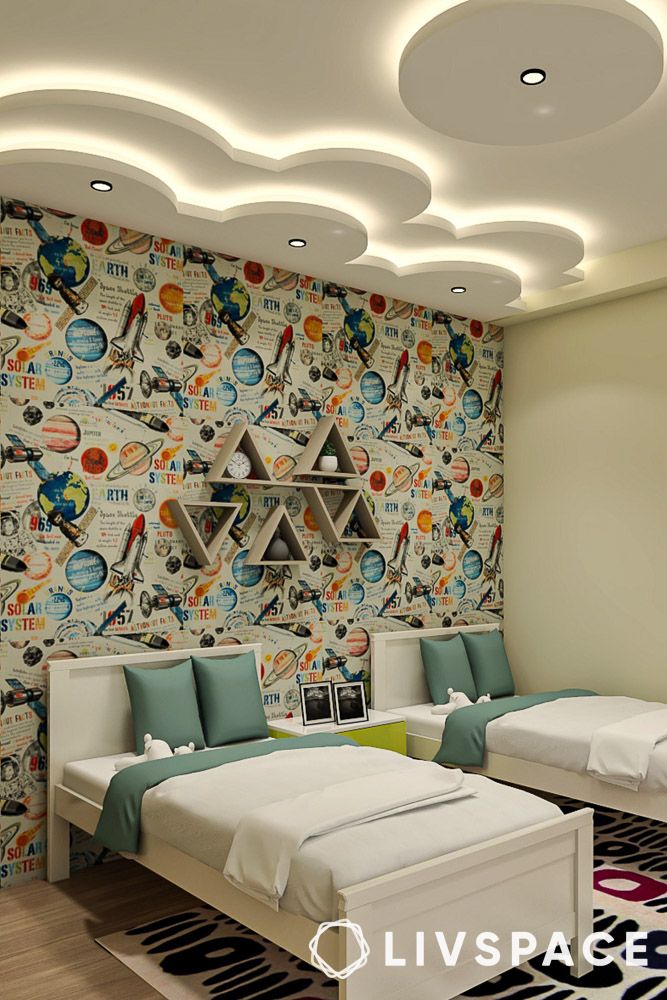
If you’re wondering how false ceilings offer safety and insulation, the answer is in the materials that are used to make them. For example, POP designs are highly resistant to fire and have excellent thermal insulation properties. It is a better option than gypsum (which basically turns to POP upon dehydration) when you need a rather mouldable false ceiling design. Consider POP designs for external parts of your house, like a POP plus minus design for your porch.
False ceiling type #10: Gypsum false ceilings
Gypsum ceiling designs are a neat-looking, stronger and more durable material than the Plaster of Paris false ceiling designs. However, gypsum has the same insulation properties and can be installed in an eco-friendly manner as it doesn’t produce a lot of toxic dust during the process. Since it attaches to the ceilings using metal frames, it is easier to install than the Plaster of Paris false ceiling design which requires moulding skills.
Also Read: 7 Advantages of Gypsum Ceiling to Convince You to Opt for a Gypsum False Ceiling
False ceiling type #11: PVC false ceiling design
Another highly durable material that is also the easiest to install is PVC. It has similar insulation properties and isn’t a brittle material. Consequently, PVC ceilings are easy to install and safe at the same time. Since this material is also resistant to moisture and weathering, it is suitable for balcony ceilings as well.
False ceiling type #12: Wooden false ceiling
Wooden false ceilings are expensive but worth all your money. They are best for rooms with high ceilings as they reduce the perception of height. They can make your large rooms appear cosier and more intimate. The reason why wood can achieve this is because wood is easier to notice compared to white ceilings, which do the opposite and make small rooms appear larger.
Also Read: 50+ Unique POP Ceiling Designs That Will Leave You Inspired
False ceiling type #13: Plywood false ceiling
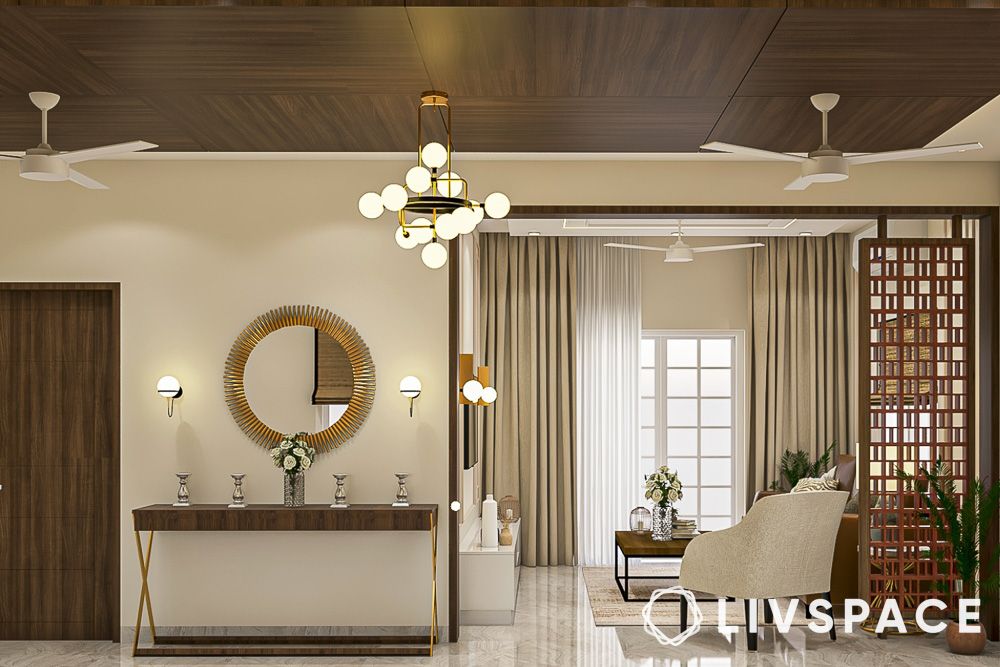
Marine plywood is the best choice for false ceiling designs that resemble wood. Known for its strength, durability and moisture resistance, well-maintained plywood false ceiling designs can last up to 20 years.
False ceiling type #14: Calcium silicate false ceiling
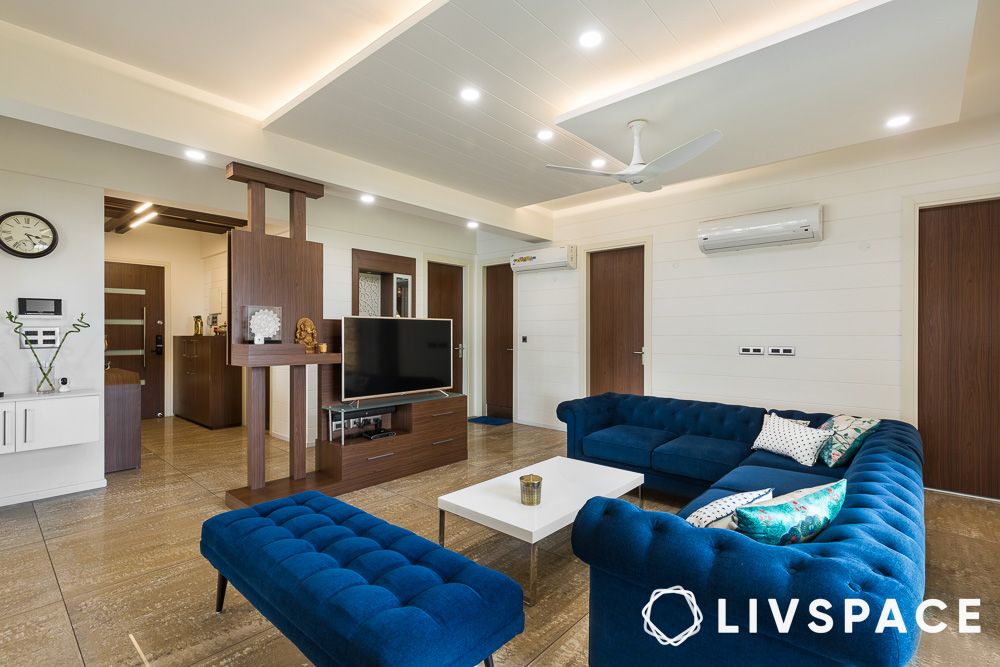
Calcium silicate false ceiling designs are known for their durability and functionality. These down ceiling designs are ideal for areas that require moisture resistance and fireproofing, making them a popular choice for both residential and commercial applications. When considering a down ceiling design for the lobby, the robust nature of calcium silicate ensures longevity and reliability. Similarly, a calcium silicate down ceiling design for a room, such as a kitchen or bathroom, offers practical benefits without compromising on style. The versatility and resilience of calcium silicate make it a smart choice for various interior settings.
False ceiling type #15: Veneer false ceiling
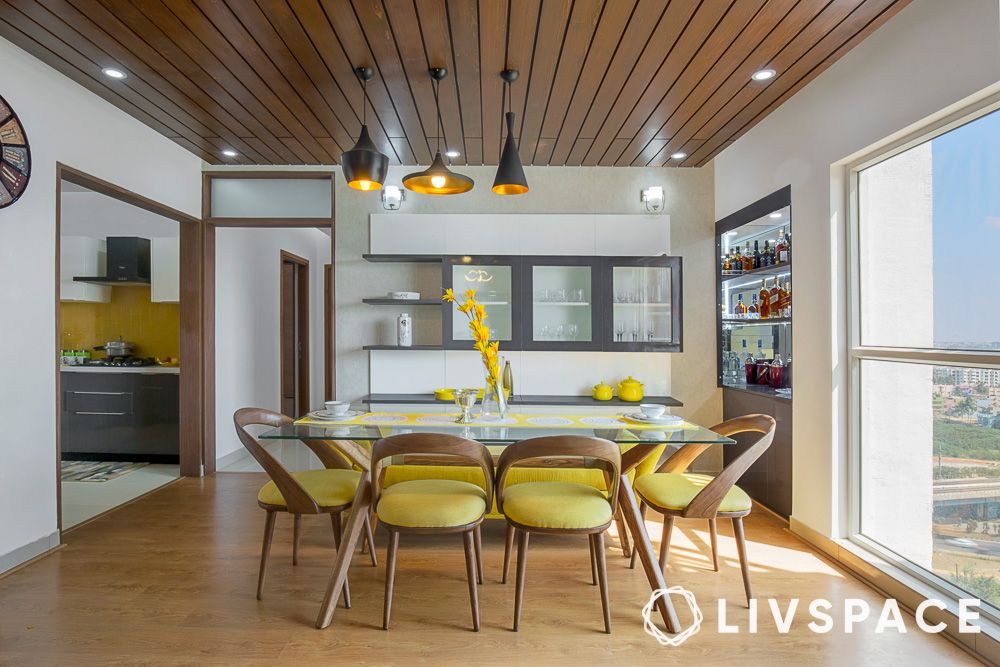
Veneer ceilings use thin slices of wood to create a rich, luxurious finish. They add a touch of elegance and sophistication to any room. Veneer ceilings are perfect for those who appreciate the beauty of natural wood.
Veneer ceilings offer a high-end look with the beauty of real wood. You can customise them to fit any design aesthetic, adding a touch of luxury to homes and offices alike.
False ceiling type #16: With acoustic panels and oak timber

Combining acoustic panels with oak timber creates a ceiling that is not only aesthetically pleasing but also functional. The acoustic panels help in sound absorption, making this type ideal for home theatres, conference rooms and auditoriums.
Acoustic panels with oak timber offer a perfect blend of style and function, creating an ideal environment for spaces where sound quality is essential.
So, which type of false ceiling is THE best?
The best type of false ceiling mostly depends on your requirements and taste, but when it comes to materials, gypsum ceiling designs are the best for home interiors. They are:
- Easy to install
- Don’t burn a hole in your pocket
- Control the transmission of heat and sound through your ceiling
- Aesthetically appealing
Is a false ceiling good for homes?
Yes, a false ceiling is a good aesthetical option to consider for your home interiors. It can uplift the look of your home by making the ceiling look higher and the room look bigger, brighter and cosier.
Which false ceiling is long-lasting?
All false ceilings endure for long periods, designed not only for aesthetics but also for practical purposes such as heat and soundproofing. Therefore, materials like gypsum, PVC, and POP, used for ceilings, offer high durability and indeed enhance the safety of your homes.
What will be the cost of false ceilings?
You can approximately calculate the cost of false ceilings by multiplying the rate of your chosen material per sq. ft. with the surface area of the ceiling that needs to be built. This calculation will give you the base cost. Additionally, you should account for the cost of finishing that your ceiling will require (paint/polish), and any electrical changes and fittings (including cove lights) in the cost of your false ceiling design.
Also Read: False Ceiling Cost 2024 | Price of PVC, Gypsum, POP Ceiling and More
Is a false ceiling expensive?
The right answer is that a false ceiling isn’t always expensive. Since you calculate its price per sq. ft., opting for minimal designs that serve the same purpose in your room can save you money. Some basic types of ceiling designs that cost less would be peripheral and island types. Given that the size of your new ceiling is in your hands, it will be easy to control your expenditure.
How can Livspace help you?
Our team of expert designers can help you create your dream homes with bespoke designs catering to your unique needs. Found inspiration from one of these images?
Reach out to us to make them a reality!
- We have delivered over 75,000 happy #LivspaceHomes
- Our team of seasoned and creative designers is ready to collaborate with you to bring your vision to life
- We conduct over 146 quality checks across various points, like manufacturing, delivery and installation
If you want beautiful interiors for your home, then look no further. Book an online consultation with Livspace today.
